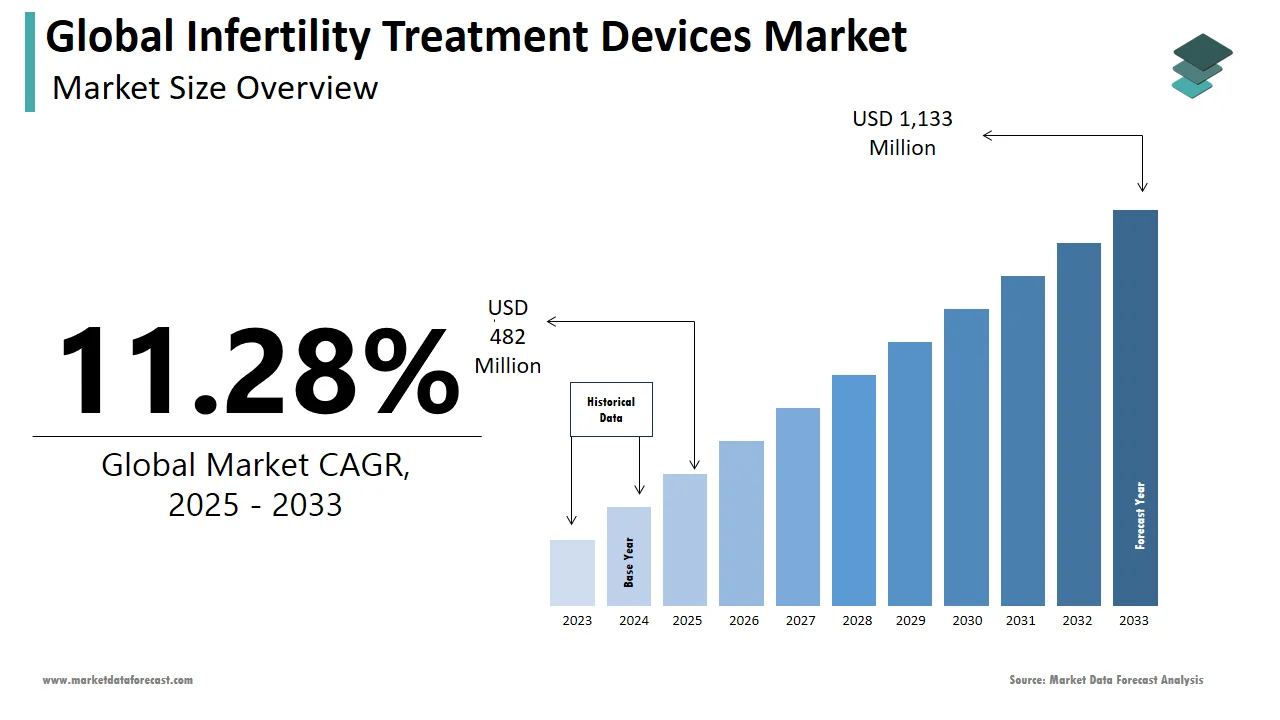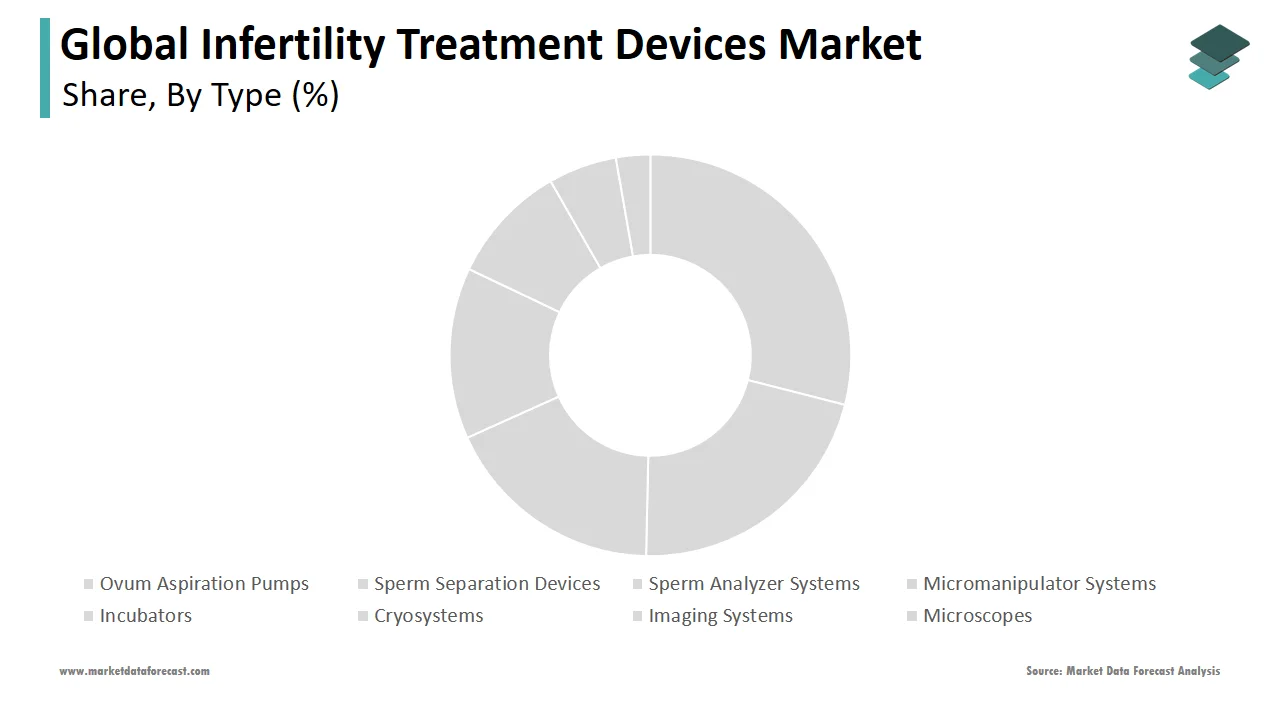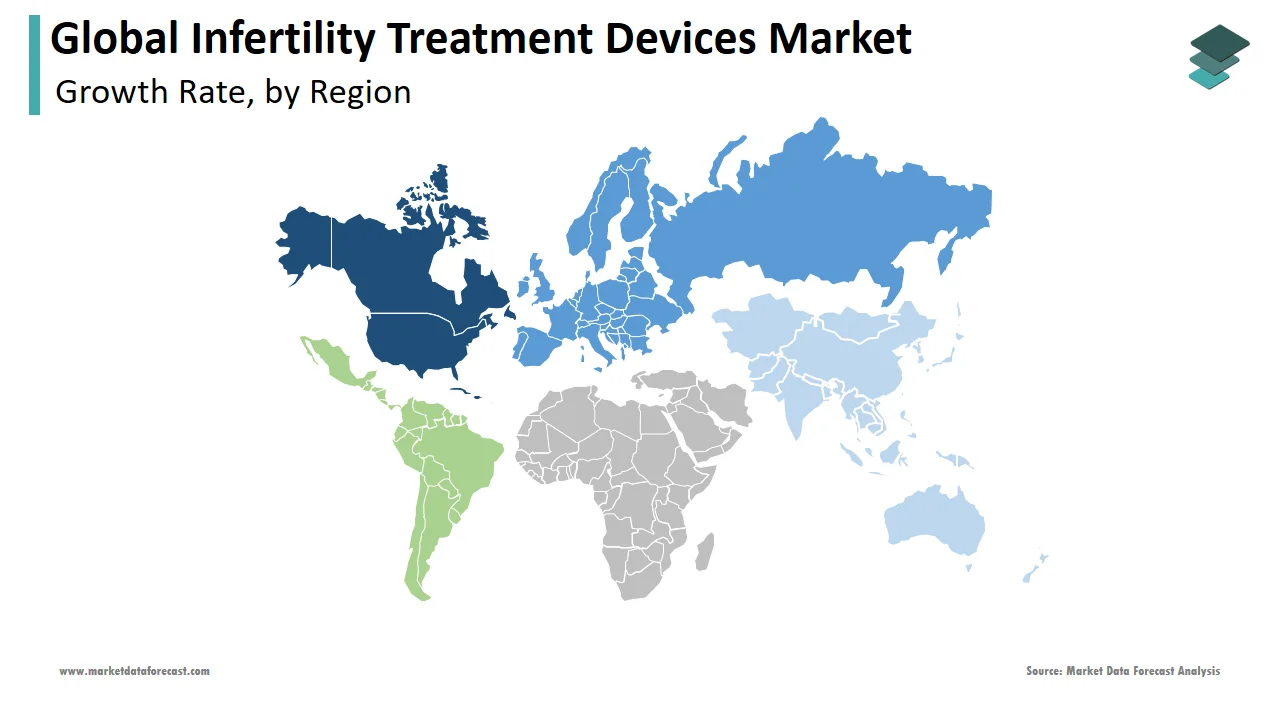Global Infertility Treatment Devices Market Size, Share, Trends & Growth Forecast Report By Type, End-user, and Region (North America, Europe, Asia-Pacific, Latin America, Middle East and Africa), Industry Analysis From 2025 To 2033.
Global Infertility Treatment Devices Market Size
The size of the global infertility treatment devices market was worth USD 433 million in 2024. The global market is anticipated to grow at a CAGR of 11.28% from 2025 to 2033 and be worth USD 1,133 million by 2033 from USD 482 million in 2025.

The various treatment devices that help with infertility issues are infertility treatment devices, which include simple interventions, medication for ovulation, and complicated procedures like assisted reproduction treatment (ART), a medical and scientific approach to help people conceive. These help in conceiving, reducing the risk of inheritance of a genetic disease by a baby, and preserving fertility. Various methods of ART include artificial insemination (AI), In vitro fertilization (IVF), intracytoplasmic sperm injection (ICSI), ovulation induction (IO), intracytoplasmic morphologically selected sperm injection (IMSI), preimplantation genetic testing (PGT), donor conception, and motherhood of substitution.
MARKET DRIVERS
The growing number of fertility clinics is one of the key factors propelling the infertility treatment devices market.
As per the estimates published by the WHO, 48 million couples and 186 million individuals have infertility. In recent years, there has been a significant increase in the number of fertility clinics along with a parallel decrease in the fertility rate in the world, which is expected to drive the growth of the infertility treatment devices market. In addition, increased focus from the governments to launch new fertility centers to increase the accessibility of infertility treatment devices, along with the expansion of fertility clinics equipped with advanced technologies, is further foreseen to drive market growth.
The other significant factors driving the growth of the infertility treatment devices market include a rise in clinical data that demonstrates the benefits of infertility treatment due to ongoing research and development in this field, rising public and private sector funding, investments from the pharmaceutical industry, high frequency of healthcare institutions offering infertility treatments for its growing success, rising awareness among the population, advancements in drug discovery, and increase in infertility in both sexes. These factors increase the demand for these devices, due to which the market for infertility treatment devices is foreseen to grow at a high rate.
The demand for infertility treatment devices is also rising because of an increasing number of couples struggling with infertility due to the increased risk of infertility due to the aging population. In addition, couples seeking medical attention for conception are also due to a further increase in diseases such as diabetes and hypertension along with age, further complicating pregnancy and leading to infertility. Therefore, these increased risks of infertility are expected to increase the potential demand for infertility treatment devices, which will support the market's growth over the next five years.
MARKET RESTRAINTS
High costs associated with infertility treatment devices, lack of qualified personnel, increase in the cost of treatment, and strict government regulations are a few of the factors hampering the market's growth. Additionally, risks of adverse infections and scarring are on the rise, which might also hurt the sentiments of various religious people, leading to low adoption of these treatments. Due to the high cost of IVF and other treatment procedures, along with national regulatory issues, these treatments are still out of reach for many people, limiting the growth of infertility treatment devices.
REPORT COVERAGE
|
REPORT METRIC |
DETAILS |
|
Market Size Available |
2024 to 2033 |
|
Base Year |
2024 |
|
Forecast Period |
2025 to 2033 |
|
CAGR |
11.28% |
|
Segments Covered |
By Type, End-User, and Region. |
|
Various Analyses Covered |
Global, Regional, and country-level analysis; Segment-Level Analysis, DROC; PESTLE Analysis; Porter’s Five Forces Analysis, Competitive Landscape; Analyst Overview of Investment Opportunities |
|
Regions Covered |
North America, Europe, APAC, Latin America, Middle East & Africa |
|
Market Leaders Profiled |
Genea Limited, Vitrolife AB, Irvine Scientific, Research Instruments Limited, The Cooper Companies Inc., Ivftech Aps, Thermo Fisher Scientific Inc., Cook Group Incorporated, and Esco Micro Pte. Ltd, and Others. |
SEGMENTAL ANALYSIS
By Type Insights

Based on type, the sperm separation devices segment is anticipated to showcase the fastest CAGR during the forecast period. This technique involves the separation of potentially fertile sperms from immobile sperms under in vivo conditions. Male germ cells undergo capacitation, an essential prerequisite for functional competence. These are primarily used in ARTs like AI and IVF as they provide purified samples that are profitable for downstream procedures.
The ovum aspiration pumps segment is also expected to showcase a healthy CAGR during the forecast period because of increased adoption. A well-established procedure, Ultrasound-guided egg retrieval is used for ovarian follicles, which are aspirated with a needle to suck out the ovarian follicles through the suction pump by creating a negative pressure. This maximizes the rate of oocyte retrieval along with reduced mechanical stress and drastic temperature changes on the oocyte.
By End-User Insights
Based on the end-user, the fertility clinics segment is anticipated to hold a significant market share due to their various benefits of providing advanced medical equipment, well-experienced professionals, and modern technology of IVF treatments like ICSI, IUI, and surrogacy, along with each case study in men and women based on the causes and severity of infertility.
On the other hand, the clinical research institutes segment is expected to account for a substantial share of the market during the forecast period owing to the rise of government initiatives, the growing popularity of IVF and ICSI, and the high establishment of clinical research institutes by significant international healthcare providers. These provide the latest care options, counsel for in vitro fertilization, genetic causes of infertility, and ways to improve sperm and egg viability for fertility improvement.
REGIONAL ANALYSIS

The North American region accounted for the leading share of the global infertility treatment devices market in 2024 owing to the financial assistance from non-tax agencies and the strong presence of charitable trusts for funding infertile people for infertility treatments, including IVF, IUI, and egg donation.
The European region is estimated to account for a promising share in the global infertility treatment devices market over the forecast period due to the expansion of facilities by market players, clear payment guidelines for infertility treatments, and high government funding for increased access to patients.
The region of Asia-Pacific is estimated to grow at a prominent growth rate during the forecast period owing to rising healthcare expenditures, a substantial rise in medical tourism, a rising infertility rate, and increased awareness of the accessibility of infertility treatment techniques. In addition, other significant factors to drive the market include various government initiatives to increase the accessibility of infertility treatment, growth in the number of fertility centers, and increasing need for infertility treatment in emerging countries like those of developed countries would undoubtedly drive the expansion of the market over the forecast period. Attributed to the exponential growth of the real estate sector, increased adoption of advanced technologies, the increased prevalence of infertility, and improved healthcare infrastructure, this region contributes to 34% of the market growth, with countries like Thailand, Taiwan, and Singapore leading the market.
The growing number of couples turning to ART, the availability of various reimbursement schemes, and cutting-edge technologies offer promising growth for fertility clinics and device manufacturers to expand their presence in the market, which is further expected to boost further regional expansion in the regions of Latin America and Africa.
The development of IVF clinics in the Middle East region is prophesied to be faster than the countries of Europe, North America, and the rest of the world, according to the evaluation of infertility treatments in different countries. This region stands for creating the first centers a few years after in European countries. The most critical factors responsible for the significant drivers of the market are the lower cost of infertility treatment services in the Middle East region, full insurance coverage on the total cost of treatment, government support, and religious values of motherhood. This leads to an increase in IVF centers and infertility treatment development, further driving the market's growth.
KEY MARKET PARTICIPANTS
Genea Limited, Vitrolife AB, Irvine Scientific, Research Instruments Limited, The Cooper Companies Inc., Ivftech Aps, Thermo Fisher Scientific Inc., Cook Group Incorporated, and Esco Micro Pte. Ltd are some of the promising companies operating in the infertility treatment devices market profiled in this report.
RECENT HAPPENINGS IN THIS MARKET
- In October 2022, Inception Fertility announced its clinical research team partnered with leading technology companies on five fertility studies, continuing its mission for advancement in reproductive science. This would improve conception outcomes and patient experience and evolve fertility services.
- In October 2022, Alife launched new artificial intelligence software after two years of research with a background in surgical robotics to help fertility clinics support clinical decisions during critical stages of the IVF process.
MARKET SEGMENTATION
This global infertility treatment devices market research report is segmented and sub-segmented into the following categories.
By Type
- Ovum Aspiration Pumps
- Sperm Separation Devices
- Sperm Analyzer Systems
- Micromanipulator Systems
- Incubators
- Cryosystems
- Imaging Systems
- Microscopes
By End-User
- Fertility Clinics
- Hospitals & Other Healthcare Facilities
- Clinical Research Institutes
By Region
- North America
- Europe
- Asia Pacific
- Latin America
- Middle East and Africa
Frequently Asked Questions
How much is the global infertility treatment devices market going to be worth by 2033?
As per our research report, the global infertility treatment devices market size is forecasted to grow to USD 1.133 million by 2033.
Which segment by type held the significant share in the infertility treatment devices market?
Based on type, the sperm separation devices segment led the global infertility treatment devices market in 2024.
Which region led the infertility treatment devices market in 2024?
Geographically, the APAC regional market dominated the infertility treatment devices market in 2024.
Who are the leading players in the infertility treatment devices market?
Genea Limited, Vitrolife AB, Irvine Scientific, Research Instruments Limited, The Cooper Companies Inc., Ivftech Aps, Thermo Fisher Scientific Inc., Cook Group Incorporated and Esco Micro Pte. Ltd are some of the noteworthy companies operating in the global infertility treatment devices market.
Related Reports
Access the study in MULTIPLE FORMATS
Purchase options starting from
$ 2500
Didn’t find what you’re looking for?
TALK TO OUR ANALYST TEAM
Need something within your budget?
NO WORRIES! WE GOT YOU COVERED!
Call us on: +1 888 702 9696 (U.S Toll Free)
Write to us: sales@marketdataforecast.com
